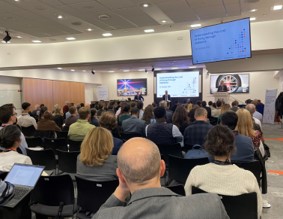Cost of living insights: engaging and diversifying users for greater reach and impact

This blog is part of our Analysis in Government Month 2023 series. You can find more articles and resources on our Analysis in Government Month hub.
With food and energy prices rising markedly for well over the past year, the Office for National Statistics (ONS) and the Government Statistical Service (GSS) have been producing a wealth of data and insight on the cost of living.
However, we knew it could be a challenge for users to know what was being produced, where, and how to navigate the data to find reliable answers to the questions that matter to them.
So that analysts, policymakers and service providers could respond to the impact of rising prices using the latest data and analysis, we set out to deliver a broad information, engagement and communications plan. This included:
- promoting Cost of Living insights and data products to a wider range of users than more traditionally known to us
- diversifying engagement including to non-expert users, such as to those in business, local government, charities and community organisations
- seeking user feedback to further develop and improve Cost of Living products and analysis
In June 2022 we published and promoted a summary of ONS’ current and future analytical work related to the cost of living, so users could see what was available and what was in the pipeline.
In September 2022 we launched the first of our fortnightly cost of living e-newsletters, which you can sign-up to. This provides a round-up of all the latest publications and analysis, along with regular social media cost of living updates on our Twitter feed.
In October 2022 we held a national conference, “Understanding the cost of living through statistics”. We invited partners to speak from trade and consumer bodies, the Bank of England, and from the world of data science, to contribute to the debate on what else was needed to understand the impact of rising costs on society. We invited a wide range of sectors to attend. We combined this with high-profile media coverage across all mainstream print and broadcast channels.

Then in December 2022 we brought cost of living data and insights together into a new Cost of Living Insights tool so users could easily find the information they need. The tool is updated at the same time as releases are published so it is “always live”.
This is more than a dashboard of charts and indicators. The Cost of Living insights tool provides commentary on the latest trends, helping users make sense of issues. It also includes tools that individuals can use – such as our Personal Inflation Calculator – so people can see how rising prices directly affect what they spend their money on.
What has been the impact from this activity?
We have been monitoring impact metrics and we know that our insights tool has received 51,208 unique views to date. We can see this is increasing, even with cost of living appearing less in the headlines. We know that 62% are public users and 28% are from national and local government. We also know that 25% visit the insights tool from reading the newsletter, 25% come via the ONS website and 21% come directly from Google. 89% of users say they found the information they were looking for.
At the conference we had over 1,000 people register to attend in person or online from a wide range of sectors and organisations from across the UK. We reached new audiences including from business, civil society, local government, as well as see our ‘more traditional’ users attend.
Both the ONS’s personal inflation calculator and shopping prices comparison tool have been huge successes, receiving wide media coverage. The success is driven by users being able to see themselves in the data we produce. The personal inflation calculator has been embedded in the Guardian and BBC’s website, while the shopping prices comparison tool reached over 700,000 uses in its first week.
In our recent stakeholder satisfaction survey, we were pleased that 91% of respondents agree that: “ONS produces stats relevant to issues of the day”.
What’s next?
The Cost of Living information and engagement work has been a collaborative effort involving analysts, economists, statisticians, digital publishing, communications and engagement specialists. We want to continue this way of working, and we are now considering how we take a similar approach for other hot topics.
For more information you can contact Nicola Fulton at External.Affairs@ons.gov.uk.
